With the advent of cheaper, more reliable digital signage and the increasingly easy-to-use software to run it, more businesses than ever are swapping out their static printed displays. Quick service restaurants (QSRs) in particular have seen the benefits of digital signs in terms of the convenience and added benefits they offer. Burger King, for instance, saw an average increase in 63% for their ticket sizes after changing over to digital signs for all their franchises.
Here are some of the best ways digital signs can enhance your QSR’s operations and customer journey:
Visual Interest
Customer wait times can often be a barrier to satisfaction while queuing up to place orders or pick up orders. A digital sign system is not only brighter and more colorful, it can also offer dynamic video displays to captivate people in line. This form of mild entertainment not only reduces customer perception of wait times, but it also enhances the desirability of certain menu items or promotions.
Hassle-Free, Consistent Signage
Static menus have multiple drawbacks. For one, they require time and effort to switch over. Employees may encounter complications when changing time-sensitive selections such as switching from lunch to dinner menus or altering daily specials. This process increases labor costs and reduces the time employees could spend performing more valuable functions like cleaning the dining room or getting ahead on prep work.
Careful oversight must also be used to ensure that mistakes were not made in addition to ensuring that signage abides by the latest standards from marketing or operations. An on-shift manager must check to see that employees completed their task accurately, and regional auditors must periodically review stores for up-to-date displays while also checking store practices.
With digital signs, the entire process can be reduced to just a few clicks. Rotating offers and specials can be queued up to automatically change based on the time of day or effective period. A manager could make changes or double check that the signs are properly adjusted without ever having to actually set foot in the store. Regional offices can quickly audit store signs to check that all franchises or locations are consistent across the board. This convenience promotes accuracy and frees up valuable time to focus on more important matters.
In-Store Marketing Potential
The eye-catching capabilities of bright, dynamic displays extend beyond easy-to-read lettering and mouth-watering pictures and video. Customers can see a rotating carousel of offers on certain menu sections to cover limited time specials or combo discounts. These displays free up menu space to make signs more compact and take up less store real estate, contributing to a streamlined, minimalistic appearance.
Furthermore, a customer who has arrived at the POS can see the menu automatically adjust based upon their order. Rather than encouraging a cashier to push side items, the menu can be connected to the POS to alter the display to show complementary items based upon the customer’s in-progress order.
Options like fries, drinks, salads and desserts can all pop up dynamically to create just-in-time offers that force customers to make split-second decisions based on their field of vision. Often, this dynamic display contributes to increased ticket sizes more so than static offerings or options. Nutrition facts can also be displayed in real time to comply with the latest federal health regulations.
All of these capabilities take the level of sophistication for QSRs and restaurant chains to new, futuristic heights. A software suite like the one offered by Digital Social Retail can be used to manage digital signs, in-store audio, social media, and beacon proximity messaging, while also managing analytics. To learn more about one simple product can revolutionize your brand’s technology solutions, visit our products page.






